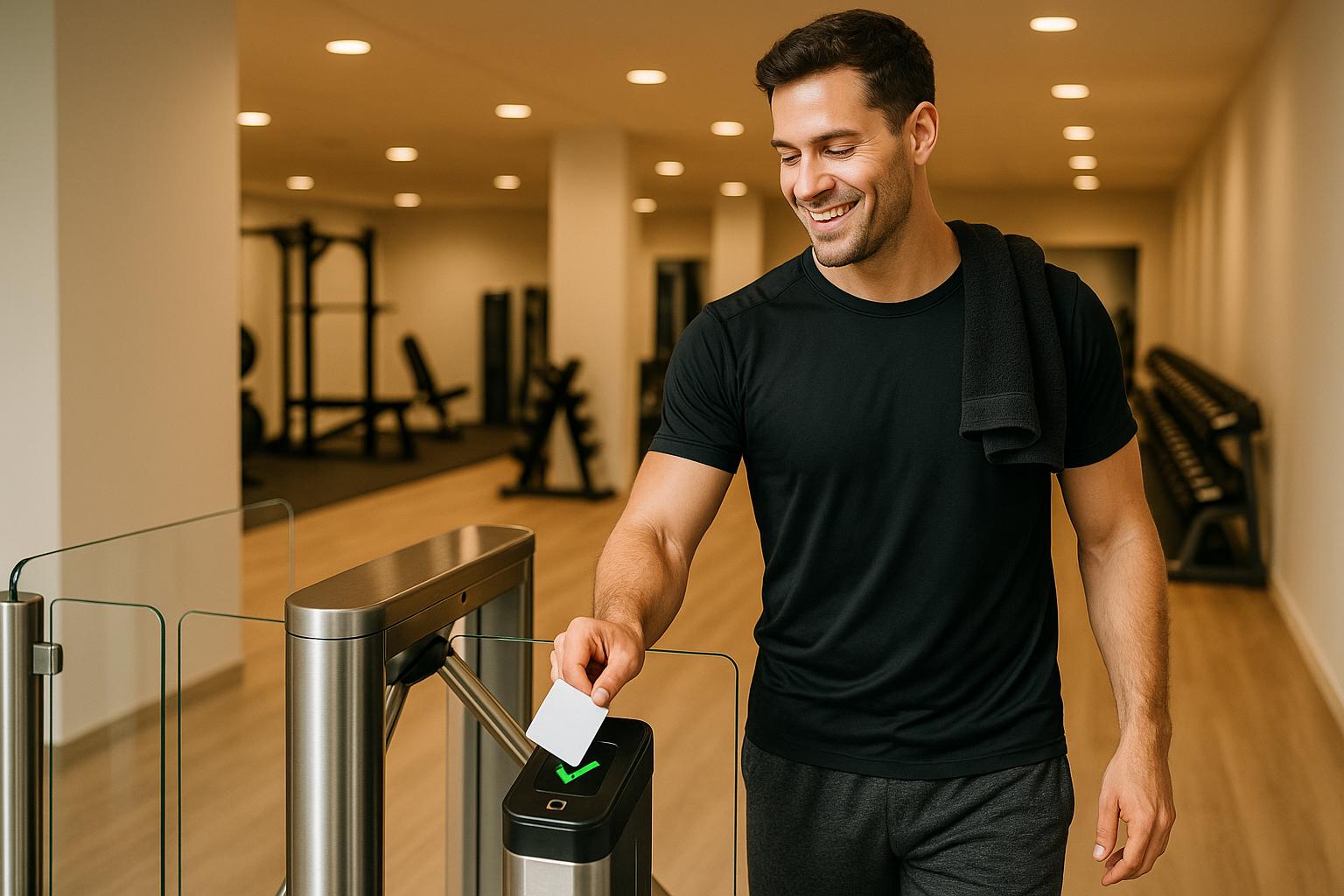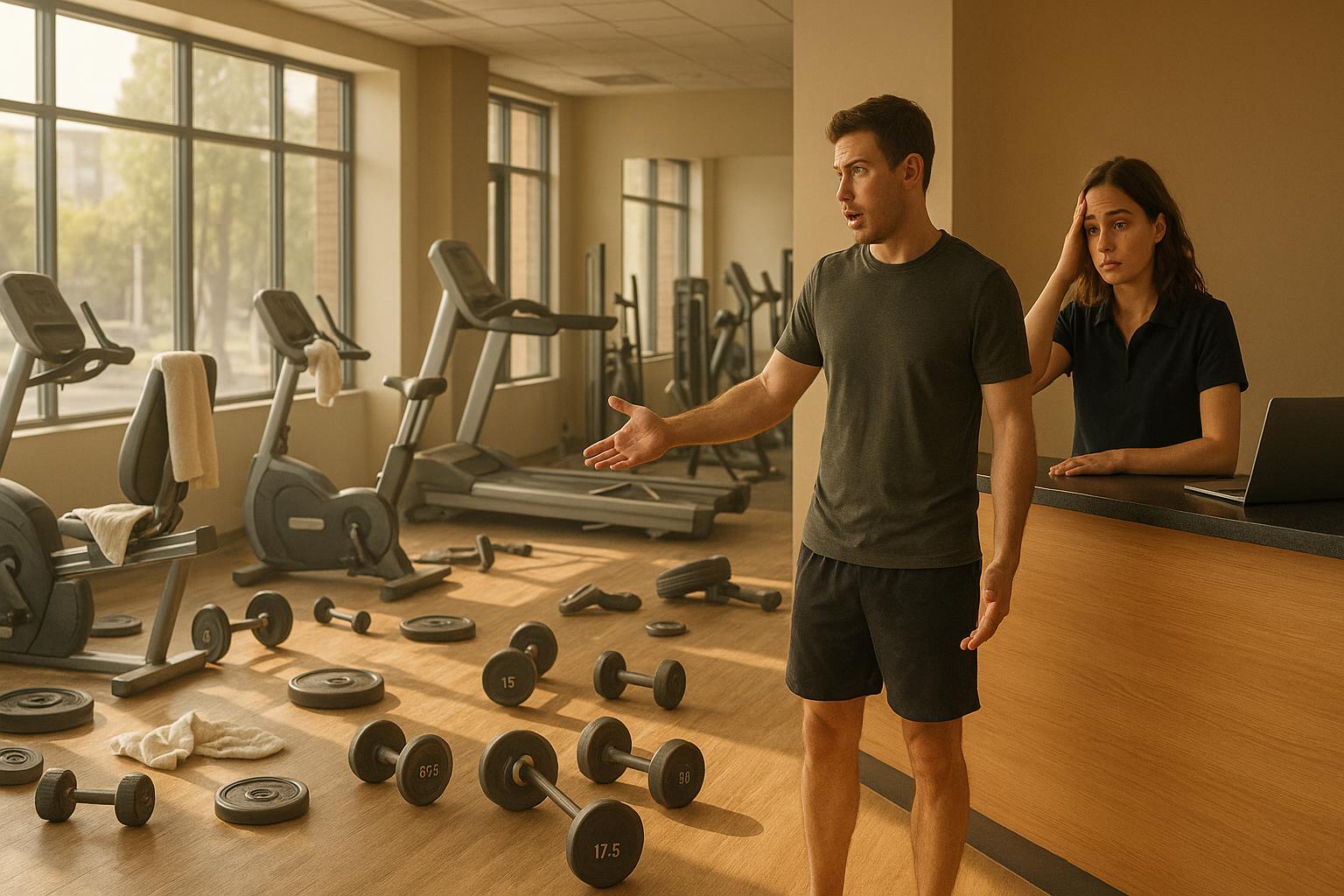Running a gym isn’t just about fitness - it’s about safety. Gym safety compliance ensures your facility meets legal standards, protects members and staff, and avoids costly fines or accidents. Here’s a quick overview:
- Why It Matters: Compliance reduces accidents, builds trust, lowers insurance costs, and prevents legal issues. Non-compliance risks fines, lawsuits, or closures.
- Key Areas:
- Equipment Maintenance: Regular inspections, detailed logs, and immediate repairs.
- Staff Training: CPR, First Aid, and emergency action plans.
- Infection Control: Cleaning routines and hazard assessments.
- Regulations to Follow:
- Federal (OSHA, ADA) and state/local rules.
- Special permits for pools, childcare, or food services.
- Technology’s Role: Tools like Fit Ops software streamline maintenance, record-keeping, and safety monitoring.
Fitness Equipment Inspection, Maintenance & Repair Services
US Gym Regulations You Must Follow
Running a gym in the U.S. means keeping up with a mix of federal, state, and local rules. These regulations are essential for ensuring safety, protecting your business, and maintaining compliance.
Federal Regulations
The Occupational Safety and Health Administration (OSHA) sets workplace safety standards that gyms must follow to protect employees from hazards and injuries. For example, in 2021, fatal workplace injuries increased, and musculoskeletal disorders remained a concern. To meet OSHA standards, gyms need to implement safety protocols, provide staff training, and keep detailed records.
Additionally, gyms must comply with Americans with Disabilities Act (ADA) requirements to ensure accessibility for all members. If your gym uses medical or rehabilitative equipment, you may also need to follow FDA standards.
State and Local Requirements
State laws vary widely and often focus on consumer protection, membership contracts, and operational guidelines. For instance, states may have specific rules about membership agreements, licensing, and pre-opening inspections. Local governments may add extra layers of regulation, such as permits, zoning restrictions, and inspection requirements.
To stay on top of these rules, start by researching your state’s fitness facility laws online. If you're unsure about certain regulations, consult a fitness industry attorney. Regularly reviewing your membership contracts to include necessary consumer protection clauses is another good practice.
Special Requirements for Specialized Facilities
If your gym offers additional services like childcare, pools, spas, or food, you’ll need extra permits and licenses. These requirements can vary by state and locality, so it’s crucial to research early and consult legal experts to ensure you have the right certifications.
For example, pools and showers often require specific health and safety permits, while childcare services may involve background checks and other legal requirements. Check with state and local authorities to ensure all specialized amenities comply with applicable laws.
Meeting these regulatory requirements isn’t just about avoiding fines - it’s also about creating a safe and trustworthy environment. Compliance helps build member confidence, lowers insurance costs, and protects your investment in your gym.
Building Your Gym Safety Compliance Program
Creating a reliable safety compliance program is essential for protecting your members, staff, and business while adhering to regulatory standards. At its core, an effective program focuses on three key areas: equipment maintenance and inspections, staff training and emergency procedures, and infection control with accessibility measures. These elements align with federal and state regulations, ensuring a safe environment that boosts member confidence and minimizes liability risks.
Equipment Maintenance and Inspections
Faulty equipment not only poses safety risks but can also lead to costly liability issues. A structured inspection process is crucial. Start with daily visual checks to identify obvious problems like frayed cables, loose bolts, or worn-out surfaces. Include components such as cables, belts, power cords, and emergency stop buttons in these assessments. Follow up with weekly functional tests to confirm proper operation and monthly in-depth inspections conducted by qualified technicians to catch potential issues early.
Keep detailed records of all inspections. Document the date, any problems found, and the corrective actions taken. This not only helps resolve liability claims but also tracks recurring maintenance concerns for long-term solutions.
Technology can simplify this process. For instance, QR code–based tracking systems, like those offered by Fit Ops Gym Management Software, let staff scan equipment and log maintenance activities directly from their mobile devices. This eliminates paperwork, ensures consistent recordkeeping, and provides instant access to maintenance logs and schedules.
Additionally, establish a clear reporting system for faulty equipment. Any item showing wear or malfunction should be immediately removed from service until repaired. This proactive approach prevents accidents and demonstrates your commitment to member safety. Once equipment safety is addressed, the focus shifts to preparing your staff for emergencies.
Staff Training and Emergency Procedures
Your staff plays a pivotal role in maintaining a safe gym environment. Comprehensive training programs ensure employees are prepared for various emergencies. All staff should be certified in CPR and First Aid, with certifications updated regularly.
Develop a detailed emergency action plan that covers scenarios such as medical emergencies, fires, and natural disasters. Clearly define roles, communication protocols, and evacuation procedures to ensure staff can respond effectively to any situation, from minor injuries to major crises.
The importance of emergency readiness cannot be overstated. Regular drills familiarize staff and members with evacuation routes and procedures while providing opportunities for role-specific training. This hands-on practice enhances overall preparedness.
Make sure fire extinguishers and AEDs are easily accessible and routinely tested. Train staff on the location and proper use of safety equipment to ensure quick and effective responses during emergencies. By prioritizing emergency preparedness, you reduce liability risks and build trust in your facility’s safety measures.
Infection Control and Accessibility
Daily health and safety measures are just as critical as emergency preparedness. Infection control has become a cornerstone of gym safety, especially in light of the COVID-19 pandemic. Effective cleaning protocols remain a top priority for reducing health risks.
Implement a cleaning routine that focuses on sanitizing high-touch surfaces. Place clear signage throughout the gym encouraging members to clean equipment after use, and provide ample cleaning stations stocked with disinfectant and wipes.
Conduct regular risk assessments to identify hazards like slippery floors, malfunctioning equipment, or poor lighting. Addressing these issues promptly ensures a safer environment for everyone.
Member confidence in your safety measures is a strong indicator of program success. In 2021, 69% of gym-goers reported feeling confident in the safety protocols at their facilities. This level of trust not only improves retention rates but also generates positive word-of-mouth, helping your business thrive. Strong infection control measures are key to maintaining this trust and reducing liability risks.
An effective safety compliance program requires ongoing effort and attention to detail. By prioritizing equipment maintenance, staff training, and infection control, you’ll not only reduce risks but also enhance member satisfaction - laying the groundwork for long-term success.
sbb-itb-1efabb1
Documentation and Record Keeping Best Practices
Keeping thorough and organized documentation is your safety net during inspections, audits, or legal claims. It proves your compliance and showcases the steps you've taken to ensure safety. Well-maintained records not only protect your business but also create a roadmap for continuous improvement.
Why Accurate Records Matter
To demonstrate a proactive approach to safety, your records should include key documents like maintenance logs, incident reports, inspection checklists, cleaning schedules, staff training records, and risk assessments. Here's why each one is essential:
- Maintenance logs: These track inspections, repairs, and replacements, creating a clear timeline of equipment care.
- Incident reports: Documenting accidents or injuries provides critical details for liability protection and insurance purposes.
- Inspection checklists: Standardized evaluations ensure safety, cleanliness, and functionality are regularly checked and nothing is overlooked.
- Cleaning schedules: These outline daily, weekly, and monthly sanitization tasks, highlighting your commitment to hygiene.
- Staff training records: Keeping track of certifications, training sessions, and drills proves your team is prepared for emergencies.
- Risk assessments: These reports identify hazards and show the steps you've taken to address them.
Strong documentation doesn’t just protect you during audits - it can also lead to lower insurance premiums. Many insurers consider safety records when determining rates, so maintaining detailed records can save you money. Plus, documenting hazards and your corrective actions builds trust with members by showing your dedication to their safety.
To stay up to date, review your safety procedures annually or whenever there are changes to your facility, like new equipment, layout updates, or revised training protocols. Moving from paper to digital recordkeeping can make this process even smoother and more efficient.
Using Digital Tools for Better Record Keeping
Digital tools have revolutionized how compliance data is managed, solving common issues like misplaced paperwork or hard-to-read notes. These systems streamline the process, making it easier to access and update records.
For example, QR code systems allow instant access to maintenance logs and simplify issue reporting. Digital platforms let you report problems with photos, detailed descriptions, and timestamps, while centralizing all safety records in one secure, accessible location.
A standout example is Fit Ops Gym Management Software. This platform offers features like QR code-based equipment tracking, instant issue reporting, and mobile access with role-based permissions. Its analytics and reporting tools go beyond what paper records can offer, helping you spot trends in equipment failures, track maintenance costs, and identify recurring issues before they escalate.
Additional benefits of digital tools include:
- Automated scheduling and reminders: Never miss a routine inspection, maintenance task, or safety drill.
- Robust security: Cloud-based storage with encryption and regular backups protects your records from loss or damage, ensuring they’re always accessible - even in emergencies.
Switching to digital documentation can also reduce costs and improve efficiency. By automating routine tasks, your staff can spend more time focusing on member service and safety monitoring. Plus, this streamlined approach can contribute to better insurance rates, reinforcing your commitment to long-term compliance and proactive safety measures.
Maintaining Long-Term Compliance
Safety compliance isn’t a one-time effort - it’s a continuous responsibility. With nearly 18% of gym-goers experiencing injuries annually, it’s clear that consistent safety measures are critical. Building a program that adapts to your facility’s needs ensures safety remains a priority in everyday operations. Let’s explore how regular training, member feedback, and technology can help maintain compliance over the long haul.
Regular Staff Training and Education
Your team plays a pivotal role in maintaining safety standards, which makes ongoing training a must. Staff education should cover the essentials: proper equipment use, safety protocols, and emergency response procedures. This not only ensures everyone knows what to do but also highlights why these measures are crucial.
"Effective training ensures that workers and employers are compliant with legislation, thereby avoiding potential legal issues and claims for compensation." - Arinite
Create a structured training schedule that includes both onboarding for new hires and regular refresher courses for current staff. Focus on practical and theoretical training to cover areas like CPR and First Aid certification, recognizing signs of distress in members, and responding to emergencies like fires or medical incidents. Additionally, staff should be well-versed in equipment safety features, troubleshooting, and the latest advancements in gym technology.
Tailor training to specific roles - whether it’s front desk staff, personal trainers, or maintenance teams - to ensure comprehensive knowledge across your organization. Encourage open feedback during training sessions and provide resources like user manuals and instructional videos for ongoing reference. Regular evaluations, such as quizzes and assessments, help reinforce these lessons and maintain high safety standards.
Getting Member Feedback and Using Analytics
Members can often spot safety issues on the gym floor before staff do, making their feedback an invaluable resource. By setting up proactive feedback systems, you can quickly address compliance gaps and improve safety measures.
For example, QR code systems allow members to report equipment malfunctions instantly, promoting a shared sense of responsibility for safety. Combining this feedback with analytics offers even greater benefits. By monitoring equipment usage patterns, you can anticipate maintenance needs and address potential risks before they escalate. Regular safety audits, informed by both staff observations and member input, ensure your safety protocols remain effective.
How Software Supports Long-Term Compliance
Modern gym management software plays a key role in maintaining consistent compliance. These tools automate routine tasks, track maintenance schedules, and provide the data needed to make informed decisions about safety.
Take Fit Ops Gym Management Software, for example. This platform integrates daily task management, analytics, and issue resolution into one seamless system. Its QR code-based equipment tracking feature provides instant access to maintenance logs and simplifies the process of reporting and addressing issues.
Fit Ops also offers robust analytics capabilities, helping you monitor equipment usage, track maintenance costs, and identify recurring problems before they become major hazards. Features like automated scheduling for inspections, reminders for safety drills, and centralized safety record storage make compliance management more efficient.
At just $39 per location per month, Fit Ops includes unlimited equipment tracking, user access, and ticket management. As one user noted:
"Safety is not just a goal but a commitment to the well-being of everyone involved in fitness classes." - Spark Membership
Additionally, digital waivers and agreements ensure members acknowledge and adhere to safety policies. The software also streamlines tasks like managing bookings, tracking equipment usage, and sharing safety guidelines, making it an essential tool for long-term compliance efforts.
Conclusion and Key Takeaways
Gym safety compliance isn’t just about ticking boxes; it’s about creating a foundation of legal protection, operational efficiency, and a reputation that members can trust. This guide has highlighted how a well-rounded safety program safeguards not only your members but also your business’s future.
Strong compliance measures impact every aspect of gym operations. Failing to meet health and safety standards can result in costly fines, while demonstrating compliance can set your gym apart, especially when clients demand proof of robust safety protocols. Acting ethically fosters trust, helping members feel secure and valued.
To maintain a safe and thriving gym environment, focus on these core areas:
- Regular risk assessments to spot and address potential hazards.
- Detailed maintenance schedules to ensure equipment stays safe and functional.
- Comprehensive staff training to instill safety knowledge and protocols.
Member education and careful capacity management also play a key role in creating a secure atmosphere.
The advantages of compliance go beyond safety. A secure workplace boosts employee morale and productivity, while ethical leadership creates a positive culture for both staff and members. For instance, one independent gym saw a 30% drop in staff turnover by offering trainers access to fitness certifications and nutrition workshops.
Technology takes these efforts even further. Tools like Computerized Maintenance Management Systems (CMMS), such as Fit Ops, streamline compliance processes. These systems can automate safety inspections, track adherence to standards, and generate audit-ready reports, all while improving efficiency and cutting costs. Health and safety software isn’t just a convenience - it’s a critical tool for building a sustainable and successful gym.
Compliance requires ongoing dedication. Regular training minimizes legal risks and shows regulators your commitment to maintaining high standards. Additionally, compliance software can reduce expenses tied to fines, legal disputes, and compensation claims.
Ultimately, your gym’s success hinges on creating a space where members feel protected and staff are empowered to uphold safety standards. By applying the strategies discussed here and embracing modern technology, you’re not just adhering to regulations - you’re building a gym that stands out in the competitive fitness industry. It’s a place defined by safety, efficiency, and trust, ensuring long-term success for your business.
FAQs
What are the key steps to ensure gym safety compliance?
Creating a strong gym safety compliance program requires a few key steps. Begin by developing a written safety and health plan that outlines the roles of leadership, encourages staff involvement, and provides clear instructions for identifying and managing potential hazards. Regularly inspect equipment and stick to a maintenance schedule, keeping thorough records to ensure everything stays compliant.
Provide ongoing training for your staff so they’re familiar with safety protocols and know how to handle emergencies. Use easy-to-read signage to guide both staff and members, and carry out frequent hazard assessments to tackle risks before they become issues. Building a safety-first culture not only keeps your gym in line with U.S. regulations but also creates a safer and more welcoming atmosphere for everyone.
How does Fit Ops gym management software help ensure safety compliance and streamline operations?
Fit Ops gym management software is designed to help gym owners stay on top of safety standards while simplifying day-to-day operations through automation. Whether it’s scheduling routine equipment maintenance, conducting safety inspections, or organizing compliance documents, the software minimizes human error and keeps safety protocols consistent.
Key features like real-time issue reporting, digital checklists, and data-driven maintenance tracking allow gyms to quickly identify and resolve potential issues. This ensures a clean and secure environment for members. By streamlining these processes, Fit Ops not only boosts operational efficiency but also enhances the overall experience for gym-goers, creating a space that’s both safe and well-maintained.
What federal and state safety regulations should gym owners follow to stay compliant?
Gym owners across the United States are required to adhere to federal OSHA standards, which address critical areas like equipment safety, sanitation, and emergency protocols. Beyond these, the Sports Facility Safety Act mandates certified inspections to confirm that sports facilities meet safety regulations.
On top of federal rules, state-specific laws often come into play. These can include capacity limits, accessibility requirements under the ADA (Americans with Disabilities Act), and regulations for outdoor activities. Being aware of both federal and state guidelines is essential for gym owners to create a safe space, steer clear of legal troubles, and provide a welcoming environment for their members.


